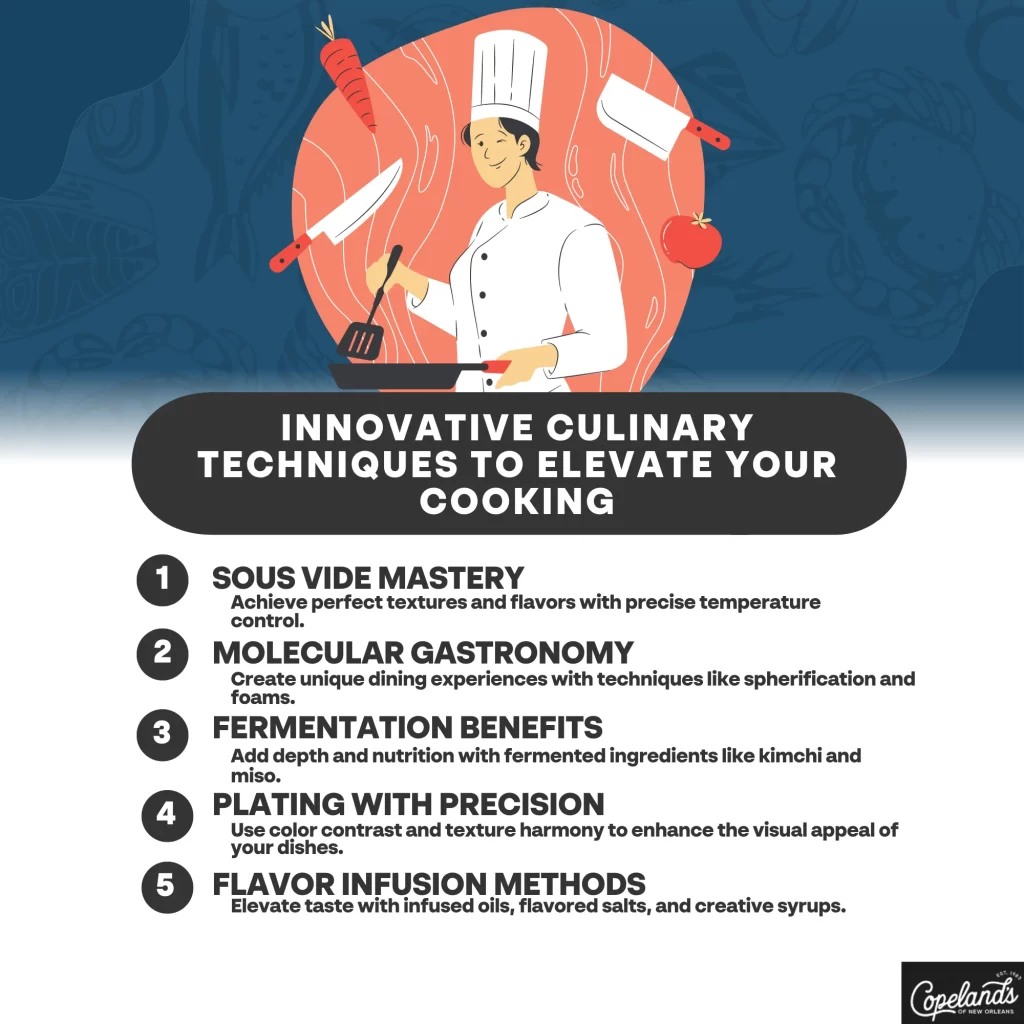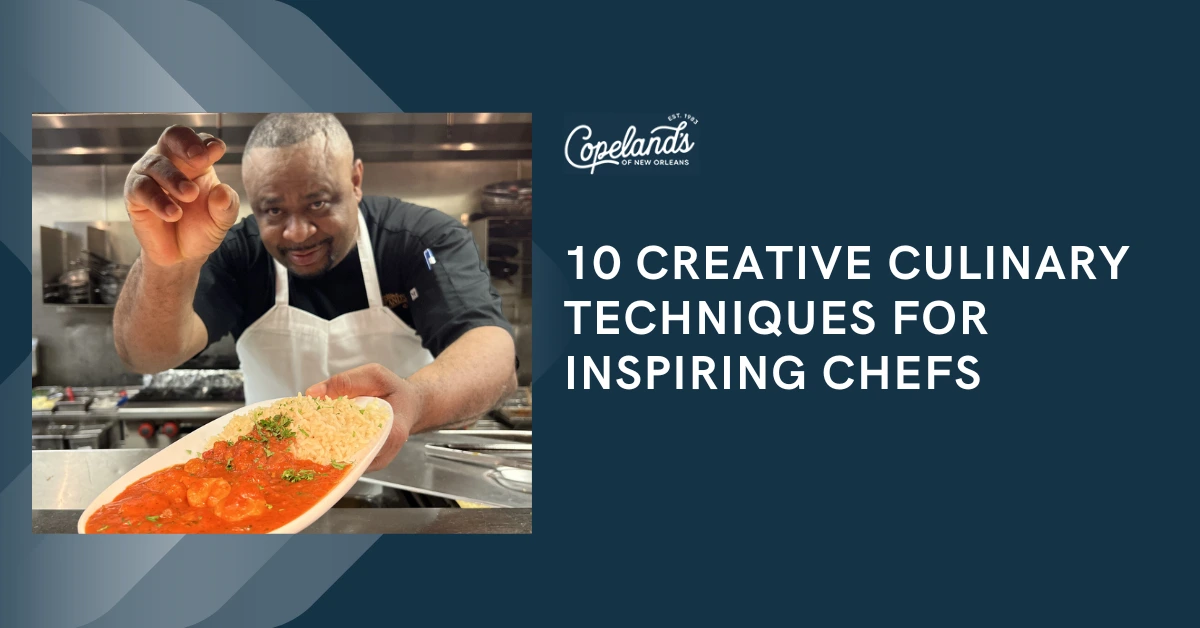If you’re looking to ignite your culinary creativity, try these 10 techniques! Start with sous vide mastery for perfect textures, or experiment with molecular gastronomy to create stunning dishes. Fermentation adds depth and health benefits while plating with precision transforms meals into visual art. Get adventurous with flavor infusion methods to elevate taste, and don’t forget dehydration for exciting textures. Sharpen your knife skills and master emulsification techniques for delicious dressings. Finally, embrace sustainable sourcing to enhance ingredients’ freshness and support local farmers. Excited to explore these? There’s plenty more to uncover about these techniques.

Key Takeaways
- Sous vide ensures precise cooking temperatures, enhancing flavors and textures in various ingredients, from meats to vegetables.
- Molecular gastronomy techniques like spherification and aromatic foams create unique culinary experiences and surprising textures.
- Fermentation enriches flavors and nutritional value, transforming simple ingredients into vibrant dishes with probiotic benefits.
- Plating emphasizes visual appeal through color contrast, textural harmony, and symmetry, elevating the dining experience.
- Flavor infusion methods such as citrus zest and tea infusions add complexity and depth to sauces and marinades.
Sous Vide Mastery
Sous vide has taken the culinary world by storm, and it’s easy to see why. This innovative cooking method consistently achieves perfect doneness, revealing incredible textures and flavors in your food.
To get started, familiarize yourself with the sous vide basics, including the essential equipment you’ll need, like immersion circulators and vacuum bags. Additionally, implementing a Food Quality Control System can help guarantee that your ingredients are safe and of the highest quality, enhancing your cooking experience.
Safety is vital in sous vide cooking. Always verify that you follow proper safety guidelines by cooking at the right temperature. This will help eliminate harmful bacteria while keeping your food delicious.
Understanding sous vide timing is key, as different ingredients require specific cooking durations for the best results.
The beauty of sous vide lies in its versatility. You can whip up everything from tender meats to perfectly cooked vegetables, showcasing a variety of sous vide applications in your kitchen.
Explore creative sous vide recipes highlighting the enhanced flavors and textures you can achieve, transforming everyday meals into gourmet experiences.
With practice, you’ll master this technique, making every dish a delightful surprise for you and your loved ones. Immerse yourself, and let sous vide cooking elevate your culinary adventures!
Molecular Gastronomy Essentials
Molecular gastronomy isn’t just a trend; it’s a fascinating approach that combines science and cooking to create extraordinary culinary experiences. As you explore this world, you’ll discover spherification techniques that transform liquids into delightful spheres, often called culinary caviar.
These playful bites burst with flavor thanks to innovative flavor encapsulation methods. Excellent restaurant service can enhance the appreciation of such creative dishes, as satisfied customers are likelier to share their positive experiences with others, amplifying your culinary innovations and creating customer loyalty.
You can also experiment with edible gels and aromatic foams, adding visual appeal and unique textures to your dishes. Imagine serving a dish that features molecular layering, where each layer tantalizes the palate in a new way.
With deconstruction methods, classic recipes can be disassembled and presented in avant-garde presentations that surprise and delight.
Don’t forget the thrill of using liquid nitrogen! It freezes ingredients in seconds, allowing you to create shocking textural elements that elevate your dishes.
The beauty of molecular gastronomy lies in its ability to awaken your creativity and imagination in the kitchen. So, roll up your sleeves and let your culinary adventure begin!
Fermentation Fundamentals
Fermentation is a magical process that transforms simple ingredients into flavorful delights.
You’ll be amazed at how this ancient technique enhances taste and boosts food’s nutritional value.
Quality control guarantees consumer trust, which is crucial in the fermentation process. It helps prevent contamination and maintains the integrity of the final product.
Let’s explore the essential ingredients and popular fermented foods that can elevate your culinary creations!
Benefits of Fermentation
The benefits of fermentation can’t be overstated when it comes to enhancing flavors and preserving foods. Not only does it elevate the taste of your ingredients, but it also offers impressive health benefits. Think about the probiotic power found in fermented foods like yogurt and kimchi—these good bacteria can support your gut health and boost your immune system.
Fermentation techniques also showcase culinary versatility. You can transform ordinary vegetables into vibrant, tangy delights, adding layers of flavor to your dishes. This ingredient transformation creates a unique sensory experience, making every bite memorable.
Moreover, fermentation carries rich cultural significance, connecting you to global traditions as you explore various recipes. Whether you’re fermenting at home or sampling dishes from around the world, you’re part of a timeless fermentation timeline that celebrates creativity in cooking.
With countless creative applications, you can experiment with flavors and textures that surprise and delight.
Essential Fermentation Ingredients
When exploring the world of fermentation, it’s essential to understand the key ingredients that make the process successful. Whether you’re enthusiastic about starting kombucha brewing or about preparing kimchi, the right components can make all the difference.
For instance, a sourdough starter thrives on flour and water, allowing wild fermentation to work its magic. Similarly, miso fermentation requires soybeans and koji to develop that rich umami flavor.
If you’re venturing into tempeh making, you’ll need soybeans and a specific mold to create the right texture and taste.
Don’t forget about pickling techniques! Vinegar, salt, and spices play critical roles in preserving and flavoring your veggies.
Choosing the right fermentation vessels can also impact your results—glass jars are often a favorite for home fermenters.
Popular Fermented Foods
While exploring the diverse world of fermented foods, you’ll discover a treasure trove of flavors and textures that can elevate your culinary creations. Start with kimchi varieties offering spicy, tangy, and crunchy delights that can transform any dish. The probiotic benefits of these foods can boost your gut health, making them a win-win for your palate and well-being.
Dive into kombucha brewing, where you can craft your own fizzy, invigorating fermented beverage at home. Its tangy kick is perfect for sipping or mixing into cocktails.
For heartier options, try miso applications in soups and marinades, adding depth and umami to your meals.
Don’t overlook tempeh preparation; it’s a fantastic plant-based protein that absorbs flavors beautifully.
Experiment with different pickling techniques to create vibrant, tangy garnishes. Think about the various sauerkraut flavors you can whip up, from traditional to adventurous blends.
Incorporating these popular fermented foods into your cooking enriches your dishes and connects you to a time-honored tradition of preservation and flavor enhancement.
Get ready to start on a delicious journey!
Plating With Precision
When you plate a dish, you’re not just serving food; you’re creating an experience.
Think about how color contrast can make your meal pop, how different textures can elevate each bite, and how symmetry and balance can draw the eye.
Each element is crucial in turning your culinary creation into a beautiful masterpiece that invites everyone to dig in.
Color Contrast Importance
Color contrast plays an essential role in elevating your dishes to a feast for the eyes. Understanding color psychology allows you to create visual appeal that draws in your diners and enhances their overall sensory experience. Think about how vibrant reds, greens, and yellows can ignite excitement, while soft pastels might evoke calm.
When you apply effective plating techniques, consider ingredient pairing that embraces color theory. For instance, pairing a rich green basil with a bright red tomato looks stunning and showcases your artistic expression.
Aesthetic balance is key here; too many colors can overwhelm, while too few might leave your plate looking dull. As you experiment with different combinations, remember that every dish tells a story. Use color contrast to convey emotions and create a memorable experience.
You’ll find that a well-contrasted plate doesn’t just please the eye but also invites diners to dig in with enthusiasm. So, don’t shy away from bold colors—embrace them! Your culinary creations won’t only taste great but also look like masterpieces that make every meal an occasion to celebrate.
Textural Harmony Essentials
Textural harmony is just as essential as color contrast in creating visually appealing dishes. When you plate your creations, think about how different textures can elevate the dining experience.
Textural contrasts add depth, making each bite a delightful journey for the senses. Imagine the crunch of a toasted nut against a creamy purée or the softness of a poached egg paired with crispy greens.
Here are three key elements to reflect on for achieving textural harmony:
- Crunchy Elements: Think of crispy fried onions or toasted breadcrumbs that add a delightful crunch.
- Creamy Components: Incorporate smooth sauces or purees that provide a rich mouthfeel.
- Chewy Textures: Add ingredients like roasted vegetables or grains to introduce a hearty chew.
Symmetry and Balance
Achieving textural harmony sets the stage for the next important aspect of plating: symmetry and balance. When you plate your dish, think about how each component interacts visually. Ingredient symmetry creates a sense of order, making your food more inviting.
Picture a perfectly arranged plate, where every element contributes to the visual aesthetics. To achieve culinary proportions, distribute ingredients evenly across the plate. This not only enhances the overall look but also promotes flavor balance.
When diners see a well-balanced plate, they instinctively feel more excited about the meal. Use shapes and colors to guide the eye, drawing attention to key aspects of your dish.
Don’t shy away from asymmetry when it feels right; aim for deliberate choices that enhance the experience. A splash of sauce here, a sprinkle of herbs there—these touches can create harmony even in an unbalanced design.
Flavor Infusion Methods
Flavor infusion methods can elevate your dishes from ordinary to extraordinary, bringing depth and complexity to your culinary creations. By incorporating infused oils, flavored salts, and herbal extracts, you can transform simple meals into flavor-packed experiences.
Imagine drizzling infused oil over a salad, or sprinkling flavored salt on grilled vegetables!
Here are some delightful infusion techniques you can try:
- Citrus Zest: Add bright notes to dishes by grating fresh citrus zest into your sauces or marinades.
- Tea Infusions: Use brewed tea as a base for soups or sauces, infusing them with unique flavors.
- Savory Syrups: Create syrups from herbs or spices to drizzle over roasted meats or desserts, adding a surprising twist.
Remember fruit essences and wine reductions to enhance your sauces or aromatic broths for soups that warm the soul.
Spice blends can also bring exciting layers of flavor to your dishes. With these methods, you’re not just cooking; you’re crafting memorable meals that ignite the senses.
Get creative and let your culinary imagination run wild!
Smoke and Sear Techniques
Smoke and sear techniques can transform your cooking game, infusing dishes with rich flavors and enchanting aromas. By mastering these methods, you’ll create unforgettable meals that will impress family and friends.
Cold Smoking and Hot Smoking
Cold smoking adds a subtle smoke infusion without cooking the food, perfect for cheeses or fish. In contrast, hot smoking cooks and flavors your meat simultaneously, creating delightful smoke rings that signal a well-executed dish.
Reverse Searing
Try reverse searing for meats. Start by cooking your protein slowly at a low temperature, allowing flavors to layer beautifully. Once it reaches the desired doneness, sear it quickly on high heat to develop those coveted sear marks.
Wood Selection
Your choice of wood plays a significant role in flavor. Experiment with hickory, mesquite, or fruitwood to find your favorite profiles.
Seasoning Techniques
Don’t forget the seasoning! Use a mix of herbs and spices to enhance the smoke’s depth. Plus, explore grill alternatives like stovetop smokers for year-round enjoyment.
With these techniques, your culinary creations will always stand out at the dinner table!
Dehydration for Texture
Dehydration is a game-changer in the kitchen, transforming ordinary ingredients into exciting textures that surprise your taste buds.
Imagine the crunch of a dehydrated apple slice or the intense flavor of sun-dried tomatoes; these innovative methods can elevate your dishes in ways you never thought possible.
Let’s explore the benefits of dehydration and how you can use it creatively in your cooking!
Benefits of Dehydration
How can the process of dehydration transform your food experience? It’s all about texture enhancement and elevating your culinary creativity. Dehydration helps you create snacks that aren’t only delicious but also packed with concentrated flavors. Removing moisture preserves nutrients, ensuring that your ingredients maintain their health benefits while extending their longevity.
Consider these delightful aspects of dehydration:
- Snack Versatility: Transform fruits, vegetables, or even meats into crunchy delights that are perfect for on-the-go munching.
- Flavor Concentration: Intensify the taste of your ingredients, making every bite a burst of rich flavor.
- Storage Efficiency: Enjoy the benefits of moisture control, allowing you to store food safely for longer periods without spoilage.
Using dehydration equipment, you’ll discover how easy it’s to maximize ingredient longevity while keeping food safety in mind.
Whether creating a trail mix or adding texture to soups, dehydration opens up a world of possibilities. So, roll up your sleeves and get inspired—your taste buds will thank you for it!
Innovative Dehydration Methods
Innovative dehydration methods can truly elevate your culinary game when it comes to enhancing the texture of your dishes. Imagine transforming fresh fruits into chewy fruit leather or creating crunchy herb chips that add a burst of flavor.
By carefully controlling moisture, you can craft vegetable crisps that aren’t only delicious and retain nutrients. Using dehydration, you can concentrate flavors into spice powders and powdered broths, making your seasonings more vibrant.
When you sprinkle these over your dishes, you’re not just adding flavor; you’re enhancing the overall texture, too. Dried garnishes, like crispy shallots or garlic, bring a delightful crunch to soups and salads.
These techniques offer amazing texture enhancement while ensuring nutrient retention. You’ll find that dehydrated ingredients can bring new life to your culinary creations.
Whether you’re whipping up a gourmet snack or elevating a simple dish, innovative dehydration methods allow you to play with texture and flavor concentration. So, roll up your sleeves, get creative, and explore the wonderful world of dehydration. Your taste buds—and your guests—will thank you!
Creative Knife Skills
Mastering creative knife skills can elevate your culinary game, making food preparation not only efficient but also an art form. When you embrace various slicing techniques and decorative cuts, you’ll impress your guests and find joy in the process.
Here are some skills to inspire you:
- Julienne styles: Transform vegetables into thin, matchstick shapes for salads or stir-fries.
- Dicing patterns: Create uniform cubes for even cooking and presentation.
- Advanced chopping: Chop quickly and safely with ergonomic grips, ensuring precision cuts every time.
Don’t forget the importance of knife sharpening! A sharp blade is your best friend, making every slice smooth.
Explore different blade types to find what feels right for you. Practice your knife safety by holding the handle firmly and keeping your fingers tucked away.
Remember, the more you practice, the more comfortable you’ll become!
With these skills, you’ll turn everyday ingredients into culinary masterpieces. So grab your favorite knife and let your creativity shine in the kitchen!
Emulsification Techniques
Understanding emulsification techniques can transform your sauces, dressings, and spreads from ordinary to extraordinary. When you create an emulsion, you blend two liquids that typically don’t mix, like oil and water.
To achieve emulsion stability, choose your oil types carefully—olive, avocado, or grapeseed can all add unique flavors. Temperature control is essential, too. Start with room-temperature ingredients, as this helps in flavor blending.
Whisk techniques, such as a vigorous circular motion, can make a significant difference. If you’re making mayonnaise, using egg yolks provides richness and acts as a natural emulsifier, giving you those delightful creamy textures.
Don’t hesitate to experiment with vinaigrette variations. A simple mix of vinegar, oil, and seasonings can be enhanced by adding alternative emulsifiers like mustard or honey, which also boost visual appeal.
The right combination can elevate your dishes to new heights.
Sustainable Sourcing Practices
Sourcing ingredients sustainably not only supports the environment but also enhances the quality and flavor of your dishes. When you embrace sustainable practices, you create a meaningful connection with your food and the community around you.
Here are some effective strategies:
- Local Ingredient Sourcing: Choose ingredients from nearby farms to reduce transportation emissions and support local economies.
- Seasonal Produce Selection: Opt for fruits and vegetables in season; they’re fresher, tastier, and often less expensive.
- Ethical Seafood Practices: Select seafood from responsible sources that prioritize ocean health.
By building farm-to-table partnerships and participating in community-supported agriculture, you can guarantee that your kitchen practices align with regenerative farming methods.
Explore sustainable protein options that promote animal welfare, and consider zero-waste cooking techniques to minimize food waste. Remember to choose eco-friendly packaging when you shop!
Incorporating biodynamic farming principles into your sourcing can further enhance the quality of your dishes while fostering a sustainable food system.By prioritizing these practices, you not only create delicious meals but also contribute positively to the planet.
Frequently Asked Questions
What Are the Best Tools for Home Culinary Experimentation?
Invest in versatile kitchen gadgets like immersion blenders and sous vide machines to enhance your home culinary experimentation. They’ll help you create unique flavor infusions and elevate your dishes, making cooking both fun and rewarding.
How Can I Develop My Own Unique Culinary Style?
You’re blending tradition with innovation. You’ll discover your culinary voice by sourcing unique ingredients and experimenting with unexpected flavor pairings. Embrace your passion, and don’t shy away from trying bold combinations that excite your palate.
What Are Some Common Mistakes in Creative Cooking?
When you’re experimenting in the kitchen, avoid ingredient overuse; it can lead to flavor imbalance. Keep it simple, focus on balance, and let your creativity shine without overwhelming your dish with too many competing flavors.
How Do I Balance Flavor and Presentation Effectively?
You’ll want to explore diverse flavor profiles while using effective plating techniques to balance flavor and presentation. Combine colors and textures on the plate, ensuring each element complements the others for a visually appealing dish.
Where Can I Find Inspiration for New Recipes?
Think of a garden bursting with seasonal ingredients; each plant whispers a new recipe. Explore cultural influences through travel, cookbooks, and food blogs. Let these sources guide your culinary creativity and ignite inspiration for delightful dishes.
Conclusion
In the vibrant world of culinary arts, your creativity can soar like a bird in the sky. By embracing techniques like sous vide and fermentation, you’re not just cooking—you’re crafting experiences that delight the senses. Each method you explore adds a new layer to your culinary journey, inviting guests to savor every bite. So, gather your ingredients, let your imagination run wild, and remember: the kitchen is your canvas. Happy cooking!




